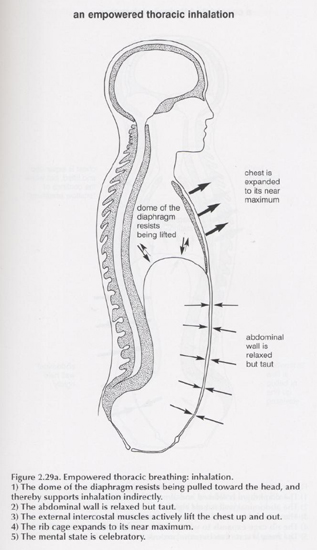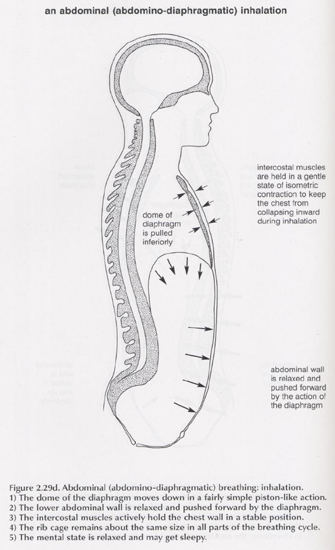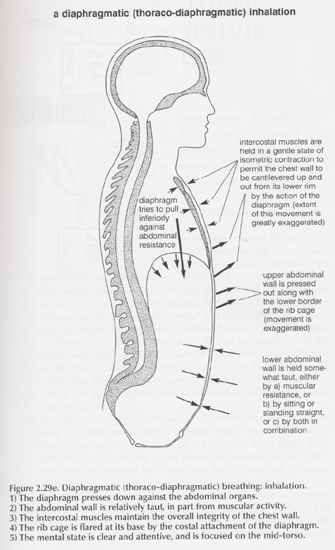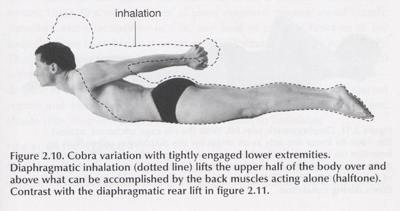Breathing
The importance of conscious breathing cannot be stressed enough. There isn't a single aspect of life that isn't affected by the quality and depth of breath. The ability to master reality is directly related to dynamic, conscious breathing.
I am going to talk about a number of types of breathing including exercises related to some of them but first it would be useful to cover breathing volume and capacity.
Breathing Volume and Capacity

There are four types of lung volumes, medically speaking. The volume of air moved in a single average, daily breath including inhale and exhale is referred to as tidal volume. It is about 1 pint or 500ml in a healthy person. The remaining capacity of lung volume that air can be inhaled with more effort is about 3,300ml or 3 1/2 quarts and is referred to as inspiratory reserve volume.
The remaining lung capacity that can be exhaled after a tidal volume is about 1000ml, called expiratory reserve volume. Since all the air in the lungs can never be completely exhaled without collapsing the lungs, there is what is called the residual volume, which remains in the lungs after a complete exhale and accounts for about 1200ml of air.
There are four lung capacities. The total average lung capacity is about 6000ml and is, not surprisingly, called total lung capacity.
The vital capacity is the total amount of air that can be breathed in and out and accounts for about 4800ml of air. In yoga when we refer to the complete breath (which I will talk about later), we are talking about breathing that uses the entire vital capacity. Just to be clear, a complete breath in yoga is inhaling as much as you can and exhaling until you cannot push your belly into your spine any more, medically referred to as the vital capacity.
The inspiratory capacity is the total amount of air that can be inhaled and accounts for 3800ml (combination of tidal volume and inspiratory reserve).
The functional residual capacity, 2200ml, is the expiratory reserve and residual volume combined. This is the amount of old air mixed with the 500ml of new air that comes in with the normal tidal volume. Did you catch that? New air is mixing with more than 4 times the volume of stale air. It gets better. The 500ml inhaled with the tidal volume passes through 150ml of dead space, called anatomic dead space, which is the air-filled space taken up by the airways, nasal passages, pharynx, larynx, trachea, right and left bronchi, and the branches of the bronchial tree that lead to the alveoli. Gas exchange of oxygen only occurs in the alveoli. So more accurately, the tidal volume is not 500ml but actually 350ml of air when taking into account dead space. Right away, you might be able to imagine how conscious breathing can make dramatic changes in blood chemistry with respect to oxygenation levels.
Constricted Thoracic Breathing

The average somewhat healthy person breathes most of the time in the mid to upper chest shallowly using only the tidal volume. The diaphragm does not get much movement because the abdomen is stationary and almost no effort is put into exhaling. The action of inhaling takes place with the muscles between the ribs, the external intercostals muscles. There are opposing muscles in the ribs called internal intercostals muscles. They are used only when effort is put into exhaling. Because there is a biological vacuum in the chest cavity, the exhale in this case requires no effort.
Shallow chest breathing or constricted thoracic breathing results in stimulating a chronic but slight over stimulation of the sympathetic nervous system resulting in increased heart rate and blood pressure, problems with digestion and elimination, and cold and clammy hands and feet.
Another drawback of constricted thoracic breathing is that most of the airflow through the lungs occurs in the upper portion of the lungs. When we are in an upright position, the part of the lungs with the most blood flow is the lower portion because the lungs get blood flow from the pulmonary arteries or the venous system, the veins (the labeling of blood vessels around the lungs and heart is a bit confusing). The pressure in the veins is about 14Hg whereas the pressure in the arteries is about 100Hg. The middle and upper parts of the lungs aren't provided with the same quality of blood flow as the lower portion (not enough pressure to push it up to the top with a decent quantity). So when we breathe shallowly in the middle and upper chest, we are bringing the fresh air to most poorly supplied part of the lungs.
To recap, constricted thoracic breathing, the most common type of breathing, takes in a very small portion of new air, mixes it with more than four times its quantity of old air, and is delivered to the part of the lungs that gets the least amount of blood flow; problems arise with stress, digestion, elimination, and blood pressure.
Empowered Thoracic Breathing

When engaged in aerobic exercise like running, the most common form of breathing is expanded or empowered thoracic breathing. With the heart beating faster and pushing more blood, the pulmonary arterial pressure is sufficient to perfuse the entire lungs with blood. There is nothing wrong with this type of breathing during exercise. Most of the work being done by the muscles of breathing is the intercostals muscles between the ribs. This can only be improved by adding more involvement with the diaphragm.

Anatomy of the Diaphragm
The highest quality forms of breathing involve the diaphragm muscle. It is a rather unusual muscle for many reasons. It acts as a separating sheath between the chest cavity and the abdominal cavity. It spans the entire torso and is composed of both muscle and tendon. Its central dome is composed of tendonous material that attaches only to the muscular parts of the diaphragm. Its tendon is the only tendon in the body that does not attach to bone. Its rim attaches to the base of the rib cage and to the lumbar spine in the rear. It is shaped like an umbrella except that it is deeply indented by the vertebral column. Because of its unusual shape, its location, and where it attaches, it can move the central tendon of the dome, the base of the rib cage, the lumbar spine, or any combination of the three.
When people talk about core muscles, the diaphragm should always be on the list and perhaps number one followed by the abdominal muscles.
Belly Breathing

Belly breathing or abdominal breathing is the first type of conscious breathing to focus on. This is the training ground for the more advanced types of breathing. In abdominal breathing the most important thing to focus on is making sure that the stomach extends out when you inhale and presses back in towards the spine when you exhale. The diaphragm extends down into the abdominal area and the organs move out of the way, down and out. One of the benefits of this type of breathing is that the organs get a little massage.
The next thing to focus on is making sure that breathing is smooth, quiet, and unbroken. One way to think about this is to imagine breathing as being elliptical, as air flows in and out, you transition smoothly from inhale to exhale. By maintaining continuity between inhaling and exhaling and exhaling and inhaling, the diaphragm is always kept in motion and actively engaged. One of the benefits of this is that the lymph fluid, which is part of the immune system and constitutes a good part of the fluid in the body, is moved by muscle contraction, most significantly the diaphragm. This strengthens the immune system and helps keep it in proper motion. When you pause between inhale and exhale or exhale and inhale, the diaphragm can go slack. When movement restarts, the diaphragm muscle jumps a bit as it is engaged. This makes for uneven, irregular breathing.
Quiet breathing is important for calming the mind and gaining control over it, particularly in meditation. Ideally you should not hear your breathing unless you are engaged in aerobic activity or ujjayi breathing like in ashtanga yoga.
Thoraco-Diaphragmatic Breathing

Once smooth, quiet belly breathing is well understood and in practice, it is time to move onto learning to breathe with the best movement of the diaphragm. Attempting to learn thoraco-diaphragmatic breathing first tends to creation confusion between proper breathing technique and one of the worst forms of breathing, paradoxical breathing (which I didn't cover). Belly breathing is great for beginners but over the long run, it produces an overly relaxed, depressed state; whereas, constricted chest breathing produces anxiety and high blood pressure. It is much better to be in the middle. Naturally then the focus of breathing should be centrally located in the torso right at the lower border of the rib cage. You can call this thoraco-diaphragmatic breathing or true diaphragmatic breathing.
Proper movement of the diaphragm involves a lifting up and out movement like lifting the handle of a bucket. When not exerting extra effort for a more aerobic experience, most of the movement of the diaphragm should be at the base of the rib cage like a spreading and opening of the lower border of the rib cage. The lower abdomen should have some isometric tension as well as the upper chest. In this way, the central tendon of the diaphragm moves up and down but less so that belly breathing. With chest breathing the external intercostals muscles provide the spreading of the ribs. Here it is because the diaphragm is making it happen. This is subtle but very different.

You can experience this type of breathing in a modified cobra pose. Lying on the stomach, the hands are clasped behind the back and pulled taut. You arch up to the sky while keeping the lower extremities tightly engaged. Breathe deeply. You'll notice that it is difficult to breathe in either the upper chest or the stomach. With each breath, the upper body lifts up and down a little and the base of the rib cage spreads. This is, in general, a good exercise to strengthen the diaphragm to breathe in this way. This is true diaphragmatic breathing!
Full Complete Breath
Full complete breathing is a variation of diaphragmatic breathing that also involves the intercostals muscles, the scalene muscles, the serratus muscles, and an increased action in the abdomen as well. The goal is to use the entire vital capacity of the lungs, 4800ml, complete inhale and exhale. This action starts with the abdomen extending out, then an expansion of the low back near the kidneys, followed by the mid chest and the sides of the chest, and then upper chest all the way up to the collar bones and first ribs. On the exhalation the reverse happens.
Full complete breathing is both cleansing and energizing. In one minute, the overall ventilation can go from about 4200ml to 14000ml. After about six breaths your blood gases will have shifted. Arterial oxygen will have moved from 100mm Hg to 120 mm Hg and arterial carbon dioxide from 46 mm Hg to 35 mm Hg. There is more oxygen in the blood and less carbon dioxide. Everything in the body works better with more oxygen.
Hyperventilation
That brings us to an interesting point. You can't get too much oxygen into your lungs when breathing but what happens when carbon dioxide levels get too low? It is called hyperventilation. Carbon dioxide has an important function in the body. It gauges the flow of blood through the small arteries and arterioles of the brain and spinal cord like a spigot on a water hose. As carbon dioxide levels decrease arterioles constrict and limit blood flow to the tissue. Oxygen levels are irrelevant in this case. When carbon dioxide levels get too low, we pass out and lose consciousness.
In yoga we use various forms of breathing that are more intense than normal breathing. It should be emphasized that the student should only put as much effort into such exercises such that they remain below the threshold of hyperventilation. This almost never occurs. Most students couldn't put enough effort into their breathing. But it should be noted that the student works themselves up to greater and greater levels of ventilation allowing the body to become accustomed to lower levels of carbon dioxide.
In the previous paragraph, I was being conservative. Hyperventilation is typically the result of shock and is unconsciously executed. Try as hard as you might, you are not likely to reach hyperventilation breathing vigorously and consciously. Muscle pain in your chest will make you stop long before hyperventilation is reached. Most of your breathing muscles are in bad shape, especially the ones in the neck and low back.
Breath of Fire
When we talk about breath of fire or bellows breath, it is not hyperventilation. A simple way to think of this type of breathing is that it is fast belly breathing through the nose. Students should only do breath of fire at a pace that balances inhale and exhale and can be done for more than a couple minutes without getting light-headed or dizzy. Speed and effort should be increased over time. This way the benefits of alertness and well being associated with higher levels of blood oxygen can be experienced.
I have been doing breath of fire daily since the about August of 2000. My upper respiratory system has gone from being all clogged up all the time to being completely clear almost all the time. Previously I was a mouth breather. To say the least, it has been a radical change. I'm just beginning to truly really appreciate the value of diaphragmatic breathing and full complete breathing.

For a more complete discussion on anatomy and yoga, get a copy of the book Anatomy of Hatha Yoga by H. David Coulter. Much of what I have written here is a summary of his chapter on breathing.